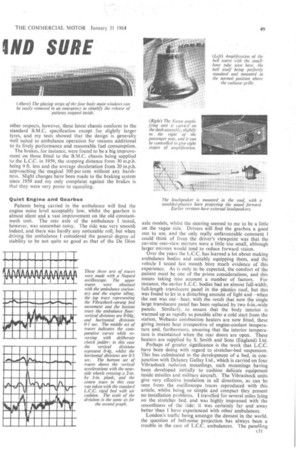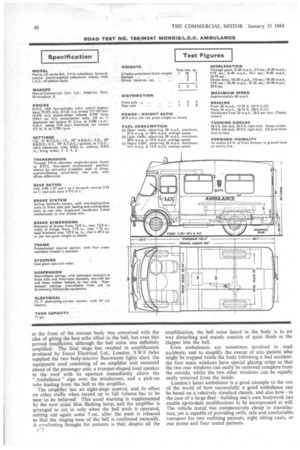SWIFT AND STEADY SMOOTI IND SURE
Page 50

Page 51

Page 52

If you've noticed an error in this article please click here to report it so we can fix it.
by John F. Moon ROAD TEST: Morris/L.C.C. Ambulance AS announced on the previous page, special Austin and Morris ambulance chassis based on the LD-series 1.5-ton van chassis have been developed by B.M.C. Two early examples of these chassis were delivered to the Supplies Department of the London County Council towards the end of last year, these forming part of an order for nine such Morris chassis which the L.C.C. are to have for the purpose of gaining service experience, and one of these was lent to me last month for road-test evaluation.
Compared with two similar ambulances with L.C.C. bodywork and B.M.C. chassis which I have tested within the past seven years, the new model showed up well in terms of fuel economy and liveliness, both of the earlier vehicles having had 46-b.h.p. versions of the LEA fourcylinder petrol engine, whilst from the road-holding and handling angles the new design was almost as good as the older models, despite having relatively conventional rear suspension as opposed to the Allard De Dion back. ends of the other two vehicles.
Because of the extra engine power, the latest ambulance was able to accelerate from a standstill to 40 m.p.h. in 3-2 sec. less than one of the original L.C.C. models that I tested in 1957, although a contributory factor towards this improved acceleration would be the synchromesh gearbox of the new chassis, the original ambulance having had the constantmesh box which was standard in LD chassis in those days. The fuel consumption rates attained with the latest ambulance were only slightly worse than those recorded in 1957, so when it comes to fuel costs there is little to choose between the two vehicles.
The more simple chassis layout has obvious advantages where price and maintenance are concerned, whilst the design is such that the standard L.C.C. all-plastics ambulance body can be mounted on it with the absolute minimum of modification, despite this body having been designed for the original Austin/De Dion chassis, some of which are still being built. Indeed, there is no obvious external difference between ambulances based on the two types of chassis, whilst inside the body the only change necessitated is the provision of a small cover in the left side of the gangway to give clearance above the off-set differential case, this cover having a maximum height of 1.5 in. at the edge of the gangway and tapering down to nothing 5 in. from the edge. Because the L.C.C. body is so light compared with more conventional coachbuilt ambulance bodies (which could weigh up to 10 cwt. more than the London body), the LD chassis being supplied to the L.C.C. have a slightly modified rear suspension, with lighter leaf springs assisted by Aeon rubber helper springs which come into action when more than about four people are being carried in the body. In other respects, however, these latest chassis conform to the standard B.M.C. specification except for slightly larger tyres, and my tests showed that the design is generally well suited to ambulance operation for reasons additional to its lively performance and reasonable fuel consumption.
The brakes, for instance, were found to be a big improvement on those fitted to the B.M.C. chassis being supplied to the L.C.C. in 1959, the stopping distance from 30 m.p.h. being 9 ft. less and the average deceleration from 20 m.p.h. approaching the magical 100 per cent without any harshness. Slight changes have been made to the braking system since 1959 and my only complaint against the brakes is that they were very prone to squealing.
Quiet Engine and Gearbox
Patients being carried in the ambulance will find the engine noise level acceptably low, whilst the gearbox is almost silent and a vast improvement on the old constantmesh unit. The rear axle of the ambulance I tested, however, was somewhat noisy. The ride was very smooth indeed, and there was hardly any noticeable roll, but when driving the ambulance I considered the general degree of stability to be not quite so good as that of the De Dion
axle models, whilst the steering seemed to me to be a little on the vague side. Drivers will find the gearbox a good one to use, and the only really unfavourable comment I could think of from the driver's viewpoint was that the car-size rear-view mirrors were a little too small, although larger mirrors would tend to reduce forward vision.
Over the years the L.C.C. has learned a lot about making ambulance bodies and suitably equipping them, and the vehicle I tested last month bore much evidence of this experience. As is only to be expected, the comfort of the patient must be one of the prime considerations, and this means taking into account a number of factors. For instance, the earlier L.C.C. bodies had an almost full-width, full-length translucent panel in the plastics roof, but this was found to let in a disturbing amount of light and—when the sun was out—heat, with the result that now the single large translucent panel has been replaced by two 6-in.-wide panels. Similarly, to ensure that the body interior is warmed up as rapidly as possible after a cold start from the station, Webasto combustion heaters are now fitted, these giving instant heat irrespective of engine-coolant temperature and, furthermore, ensuring that the interior temperature is maintained when the rear doors are open. These heaters are supplied by S. Smith and Sons (England) Ltd.
Perhaps of greater significance is the work that L.C.C. have been doing with regard to stretcher-bed suspension. This has culminated in the development of a bed, in conjunction with Delaney Gallay Ltd., which is carried on four Vibrashock isolation mountings, such mountings having been developed initially to cushion delicate equipment inside missiles and military aircraft. The Vibrashoek units give very effective insulation in all directions, as can be seen from the oscilloscope traces reproduced with this article, whilst being. so simple and compact they present no installation problems. I travelled for several miles lying on the stretcher bed, and was highly impressed with the smoothness of the ride: it was certainly far and away better than 1 have experienced with other ambulances.
London's traffic being amongst the densest in the world, the question of bell-noise projection has always been a trouble in the case of L.C.C. ambulances. The panelling at the front of the current body was conceived with the idea of giving the best echo effect to the bell, but even this proved insufficient, although the bell noise was definitely amplified. The 'final stage has resulted in amplification produced by• Easco. Electrical Ltd., London, S.W.9 (who supplied the two body-interior fluorescent lights also), the equipment used consisting of an amplifier unit mounted ahead of the passenger seat; a trumpet-shaped loud speaker in the roof with its aperture immediately above the " Ambulance " sign over the windscreen, and a pick-up tube leading from the bell to the -amplifier.
The amplifier has an eight-stage c,ontrol, and its effect on other traffic when turned up to full volume has to be seen to be believed! This aural 'Warning is supplemented by the now usual blue flashing lamp, and the amplifier is arranged to-cut in only when the bell push is operated, cutting out again some 5 sec. after the push is released so that the ringing tone of the bell is continued naturally. A comforting thought for patients is that, despite all the amplification, the bell noise heard in the body is in no way disturbing and mainly consists of quiet thuds as the clapper hits the bell.
Even ambulances are sometimes involved in road accidents, and to simplify the rescue of any patient who might be trapped inside the body following a bad accident, the four main windows have special glazing strips so that the two rear windows can easily be removed complete from the outside, whilst the two other windows can be equally easily removed from the inside.
London's latest ambulance is a good example to the rest of the world of how successfully a good ambulance can be based on a relatively standard chassis, and also how—in the case of a large fleet—building one's own bodywork can enable up-to-date modifications to be incorporated at will. The vehicle tested was comparatively cheap to manufacture, yet is capable of providing swift, safe and comfortable transport for two reclining patients, eight sitting cases, or one prone and four seated patients.




















































































































